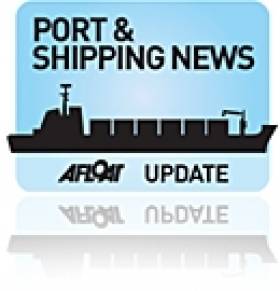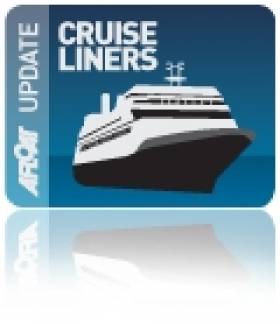Displaying items by tag: Londonderry Port
#LegenderryPort160 – Following another successful Legenderry Maritime Festival which culminated with a send-off farewell of Clipper Race yachts at the Parade of Sail on Sunday, the host port also celebrated their 160th anniversary.
Bonnie Anley, the new chairman of Londonderry Port and Harbour Commissioners commented on her delight having joined the commissioners in their 160th year. "In 1854, the Londonderry Port and Harbour Commissioners were set up to address the challenges facing a port city which wanted to expand its trading connections".
She added, "Over the past 160 years the port has played a vital role in the life of the city, from transatlantic trade and emigration, to WWII and the modern era.
The north-west port in the present day is a major economic driver for the region and handle over £1 billion worth of commodities per annum, with over 1000 associated jobs.
In 2013, the port had a a record year, with an increase of 27% in shipping. Furthermore, the port which is mostly centred at Lisahally on the east side of Lough Foyle, has acted as a hub for developing industries such as the renewable energy sector.
"We also play a key role in the development of marine leisure and cruise tourism, berthing cruise liners at Lisahally and Greencastle and running Foyle Port Marina to attract sailing and boating crews to the city".
"Providing the marine expertise to manage the arrival and departure of the Clipper Race fleet is a big part of this, and we've just finished a 40 metre extension to the Marina"
It's fantastic that the Foyle is attracting such high profile marine activity", concluded Chairman Bonnie Anley.
The commissioners are the Conservancy Authority for Lough Foyle between the harbour limits from Craigavon Bridge in the city to a line between Magilligan Point and Greencastle in Co. Donegal.
Between these locations is also where a car-ferry service is operated by the Lough Foyle Ferry Company.
Polar Cruiseship Launches London-Derry Port Season
#CruiseNorthWest – Polar cruiseship Fram, a Norwegian-flagged 418 passenger vessel operated by Hurtigruten, became the first visitor this season having docked in Londonderry today, writes Jehan Ashmore.
Fram which has a rather stout looking appearance measuring 114m long, had arrived from Stornoway, Isle of Lewis of the Outer Hebrides. She also presents a striking livery with her black hull separated from her white superstructure by a bold red band.
This colour scheme applies to her fleetmates that are not cruiseships but are essentially multi-purpose vessels that perform the role of carferry, cruiseship and cargo-carrying that 'Hurtigruten' operate daily sailings between Bergen and Kirkenes beyond the Arctic Circle and close to the Russian border.
Fram represents the cruise industry sector to the north-west port which is to welcome a further four callers this season. She is the only cruiseship to berth along the quays of Londonderry, where she docked at the city centre berth.
Two medium sized cruiseships, Delphin and Seabourn Legend are to berth downriver at Lisahally on the east side of Lough Foyle, while on the west coast, off Greencastle, Co. Donegal, the larger Adonia and Crystal Symphony are to make anchorage calls.
Since 1995, Londonderry Port has opened up for business in attracting cruiseships, and among this year's operators are P&O Cruises and Seabourn.
In total more than 4,000 passengers and crew are to visit the city which has hosted in recent years prestigious sailing events, maritime festivals and the high-profile Derry-Londonderry European City of Culture in 2013. This year the city looks forward to Music City 2014.
Londonderry Port and Harbour
Londonderry Port and Harbour
 Londonderry Port is a vibrant and rapidly developing port located in the North West of Ireland. It is a deep water port which is capable of dealing with a full range of customers’ requirements, including our specialist capability in handling bulk cargo.
Londonderry Port is a vibrant and rapidly developing port located in the North West of Ireland. It is a deep water port which is capable of dealing with a full range of customers’ requirements, including our specialist capability in handling bulk cargo.
At Londonderry Port we recognise that one of our unique selling points is our ability to meet the specific needs of each customer. The ability to tailor our arrangements brings a large degree of flexibility and innovation to our business. By doing this, LPHC has developed a strong reputation in the market for delivering on our commitments to our customers.
Our goal is to be the port of first choice for our existing and future customers. We also work hard to address the needs of others who have a stake in our business, such as employees, local authorities, the community and the Government.
About Us
Londonderry Port and Harbour Commissioners manage, maintain and administer the port for the benefit of our stakeholders by placing a strong emphasis on sustainability, and re-investing our profit for growth to benefit future generations. As part of LPHC’s core functions we serve the entire region and promote economic growth and stability – importing over £500m worth of goods into the region last year. LPHC provides a key part of the region’s public infrastructure offering port and marine services to meet our customers’ businesses need.
Our beliefs
The Port has always recognised that it is a service to our customers and must provide fast, efficient operations to meet our clients’ needs. In the last five years LPHC has developed a new fertiliser blending plant and a new oil terminal facility in conjunction with new and existing customers.
Who we support
LPHC actively supports community and economic entrepreneurship in this area, by mentoring and sponsorship of key enterprise and community projects through our work with Business in the Community. Our mentoring support for projects such as the Playhouse Activity Centre, Beautiful Day Bridal, Blueberries Pine helped develop the businesses in the right direction. This has been recognised by BITCNI with an award for supporting economic growth in Northern Ireland.
Find us here
(Details courtesy of Londonderry Port and Harbour Commissioners)
Londonderry Port and Harbour Londonderry Port & Harbour Commissioners, Port Road, Lisahally, Londonderry BT47 6FL. Tel: +044 (0)28 7186 0555, fax: +044 (0)28 7186 1168, email: [email protected]






























































